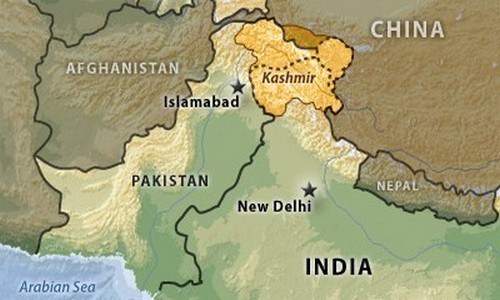Kashmir after 370
TRANSCEND MEMBERS, 16 Sep 2019
Debidatta Aurobinda Mahapatra – TRANSCEND Media Service
11 Sep 2019 – Early in August 2019, the Indian government repealed Article 370 of the Indian constitution, which provided special status to Jammu and Kashmir. The Article, a later incorporation to the Indian constitution, was titled temporary. In this article, I will focus on the implications of this decision at three levels: people within Jammu and Kashmir; the states of India and Pakistan; and the world in general and major powers in particular.
Before elaborating the implications, some facts need to be kept in mind as they will help better understand the implications. First, Jammu and Kashmir (the legal name of the disputed region, popularly called Kashmir) is a conflict since the 1940s when India and Pakistan emerged as independent states after the British departure. Second, its history is contested, and currently, it is divided between three states – India, Pakistan, and China. Third, while India claims Kashmir as its integral part, Pakistan’s position is that it supports the people of Kashmir diplomatically, politically and morally. Fourth, Indian part of Kashmir has three distinct regions – Jammu, Kashmir, and Ladakh, and it is the Kashmir valley which has witnessed intense violence in the last three decades. These facts do not speak everything about the region, but they provide a background to make a sense of recent developments.
Within the Indian side of Jammu and Kashmir the decision broadly has three implications from a legal point of view. First, it ended the special status of Kashmir including its separate flag and constitution. The special status provided the region autonomy in various policy matters, and the decision ended that and brought that region at par with other Indian union territories. Second, as the decision repealed Article 35 A along with Article 370, Indian citizens from any part of India can reside and buy property in Kashmir. Earlier, no citizen from other parts of India could buy property in the region. Third, Indian law will be equally applicable to Kashmir as to any other part of India.
The people within the Kashmir valley will be affected most by the decisions, at least from a political and psychological point of view. The people of the two other regions- Jammu and Ladakh- may not be that affected. The people in the valley, who are alienated from India, may take this decision as another step to undermine their aspirations. Kashmir valley was already witnessing intense violence after the killing of some of the militant leaders such as Burhan Wani and Zakir Musa, who professed to establish an Islamic State in Kashmir.
The implications of the decision for bilateral relations will be much more pronounced and dramatic. Kashmir conflict is one of the most protracted conflicts in the world, goading India and Pakistan to fight multiple wars and engage in numerous border clashes. The first war that started in 1947 ended after the United Nations led ceasefire, which divided Kashmir between India and Pakistan. They fought wars again in 1965 and 1971 and agreed to resolve bilateral issues peacefully. But that never happened. The neighboring states fought a limited war in 1999, ending with both the parties returning to their existing positions. Both the countries went nuclear in 1998, adding a nuclear angle to the conflict. The bitter relationship will likely be further bitter. Pakistan has already expelled India’s ambassador and recalled its ambassador from New Delhi. It also canceled trade with India. It is possible that after the Indian government relaxes its tight control, organizations like Hizbul Mujahideen, Lashkar-e-Toiba, Jaish-e-Mohammad, which have radical religious agenda, will become more active in Kashmir. Already international organizations such as Al Qaeda and the Islamic State have expressed interest in Kashmir, and they will likely be more active once the Indian restrictions on the people’s movement in the valley are lifted.
At the international level, there will not be much change in the policies of major powers towards Kashmir. Though India and China have expressed differences over the recent development during the visit of Indian foreign minister to Beijing, China, which is busy in trade conflict with the USA and in its affairs in Xinjiang and Hong Kong, is unlikely be active in Kashmir. The major powers including the United States and major international organizations like the United Nations have expressed concern over the recent developments and have urged India and Pakistan to maintain peace and tranquility in the region, and address the issue bilaterally.
The implications of the decision for positive peace in the region has not much been explored in the recent writings. Will the decision bring peace in the trouble-torn region? While India has betted on the points that the decision will bring more economic development and peace to the region, Pakistan has argued that this decision is a betrayal of the people of the Kashmir. While many Indian political parties have supported the decision of the Bharatiya Janata Party-led government, the major opposition party, Indian National Congress, has opposed the decision on the ground of its constitutionality, as it lacked the proper deliberation with all the stakeholders to the decision. As Article 370 is a major sensitive issue in India, the political parties are interested to ensure that their mass base is not eroded by their stand on this decision.
The decision has not obliterated the disputed nature of the conflict. Kashmir is divided between the three nuclear weapon states, and as it is located in a very geopolitical and strategic Himalayan region, with a border with Afghanistan, its significance for international peace and security is significant. China’s One Belt One Road initiative also includes this region, and the China-Pakistan Economic Corridor passes from China’s east to Pakistan’s west to the Arabian Sea through this region. The current decision may not significantly affect the Afghan peace process. One of the Afghan Taliban leaders has stated that Kashmir and Afghanistan need not be linked.
If Kashmir is viewed as a conflict between two religious ideologies a solution will likely be elusive. While modern states are becoming more pluralistic and draw their inspiration from the rule of law and constitutionalism, an exhortation to a religious solution to any conflict seems anachronistic. But once Kashmir is viewed as a territorial, political and historical conflict, perhaps there may be a solution. In this direction, significant peace capital was built in the 2000s after the opening of intra-Kashmir roads for trade and travel. But this capital fizzled out particularly after the Mumbai terror attack in 2008. Certainly, Kashmir is not ripe for a solution at present. Once the saber-rattling and massive media coverage, sometimes confusing fiction with fact, slow down, the political leaders of the Indian subcontinent and the people of the region will have to sit down and talk about the conflict and possible pathways to a solution. If nuclear weapons cannot bring the solution (both India and Pakistan possess them since 1998 but never used them, better sense prevailed) then the path for dialogue and deliberation must be explored. It is time to invoke Gandhi, who famously said, “there is no path to peace, peace is the only path (to conflict resolution).”
____________________________________________
 Debidatta Aurobinda Mahapatra, Ph.D. teaches political science at the University of Central Florida. He is a member of the TRANSCEND Network, director of the Mahatma Gandhi Center for Non-Violence, Human Rights and World Peace at Hindu University of America in Florida, and a fellow at the Center for Peace, Democracy and Development, University of Massachusetts Boston. He is an Indian commentator and his areas of interest include conflict transformation and peacebuilding in South and Central Asia. His edited book, Conflict and Peace in Eurasia, was published by Routledge in 2013; Conflict Management in Kashmir: State-People Relations and Peace, was published by the Cambridge University Press in 2018. His forthcoming coedited book is Gandhi and the World.
Debidatta Aurobinda Mahapatra, Ph.D. teaches political science at the University of Central Florida. He is a member of the TRANSCEND Network, director of the Mahatma Gandhi Center for Non-Violence, Human Rights and World Peace at Hindu University of America in Florida, and a fellow at the Center for Peace, Democracy and Development, University of Massachusetts Boston. He is an Indian commentator and his areas of interest include conflict transformation and peacebuilding in South and Central Asia. His edited book, Conflict and Peace in Eurasia, was published by Routledge in 2013; Conflict Management in Kashmir: State-People Relations and Peace, was published by the Cambridge University Press in 2018. His forthcoming coedited book is Gandhi and the World.
Tags: Asia and the Pacific, BRICS, Conflict, Geopolitics, Hinduism, History, India, International Relations, Islam, Kashmir, Occupation, Pakistan, Politics, Power, Religion, State Terrorism, Terrorism, Violence, War
This article originally appeared on Transcend Media Service (TMS) on 16 Sep 2019.
Anticopyright: Editorials and articles originated on TMS may be freely reprinted, disseminated, translated and used as background material, provided an acknowledgement and link to the source, TMS: Kashmir after 370, is included. Thank you.
If you enjoyed this article, please donate to TMS to join the growing list of TMS Supporters.

This work is licensed under a CC BY-NC 4.0 License.

Kashmir needs to secede !
Kashmiris need to Read the Gita !
The Gita allows the discrimination of Lower Castes ! If the Hindoos treat their own like dirt – what will they do for the Kashmiris ?
The concept of classes of humans ordained in this birth and the next birth where redemption is obtained by perpetual misery and suffering of the lower classes is anathema to Islam !
The Kashmiris are not Indians – being of Jewish,Turkish,Afghan,Persian,Mongol,Scythian ancestry – different by Race,DNA,Theology and Religion.
This the injunction of the Gita delivered by their God – Krishna
“It is far better to perform one’s svadharma (prescribed duties), even though faultily, than another’s duties perfectly. Destruction in the course of performing one’s own duty is better than engaging in another’s duties, for to follow another’s path is dangerous.” – Bhagavad-Gita 3:35.
“According to the three modes of material nature (goodness, passion, ignorance) and the work associated with them, the four divisions of human society (Brahmin/KsHatriya/Vaisya/Sudra) are created by Me .And although I am the creator of this system, you should know that I am yet the nondoer, being unchangeable.” — Bhagavad-Gita 4:13.